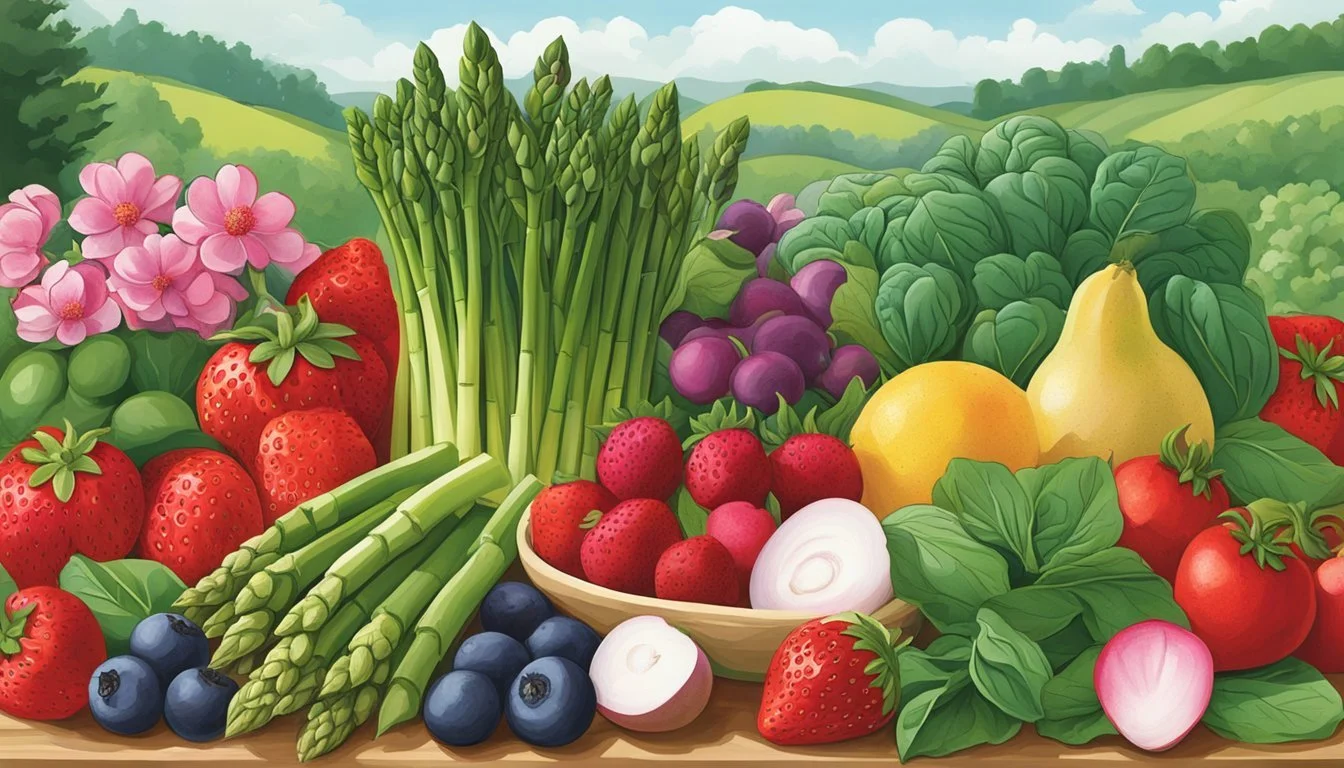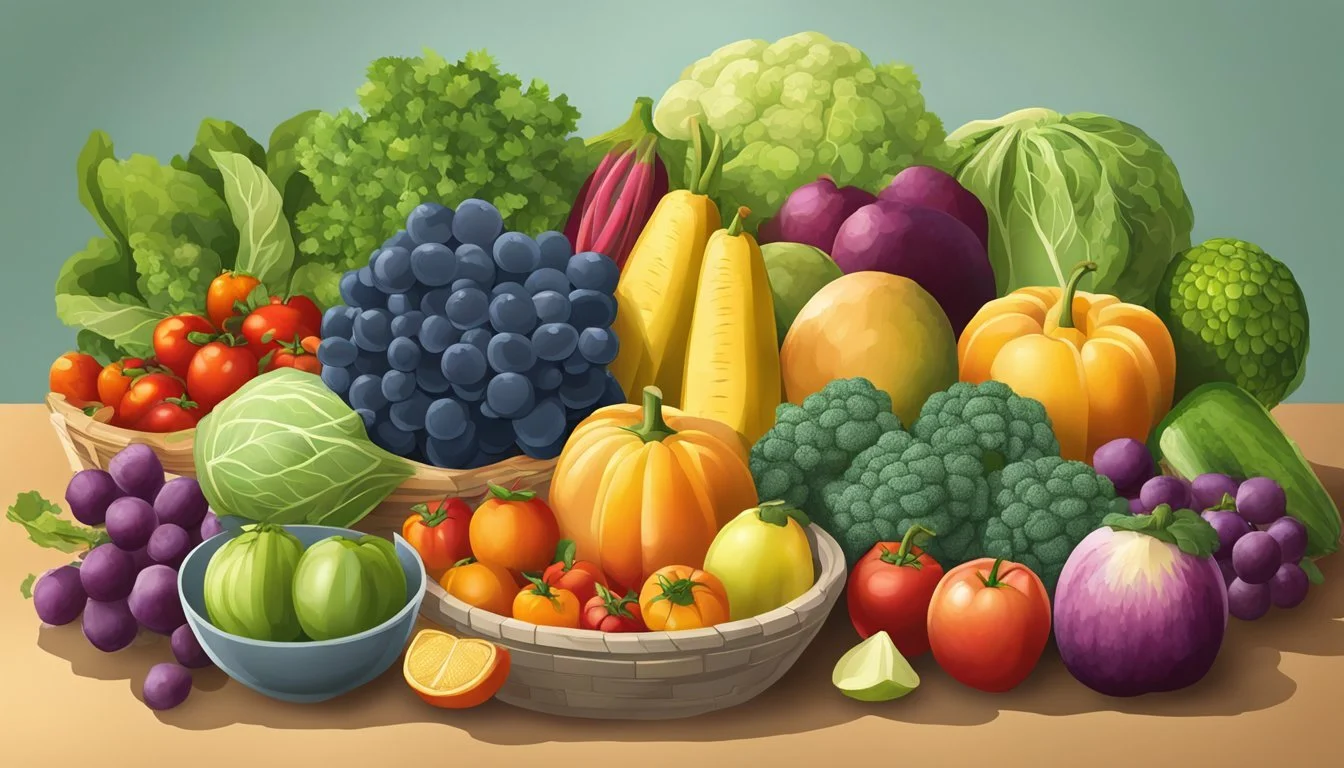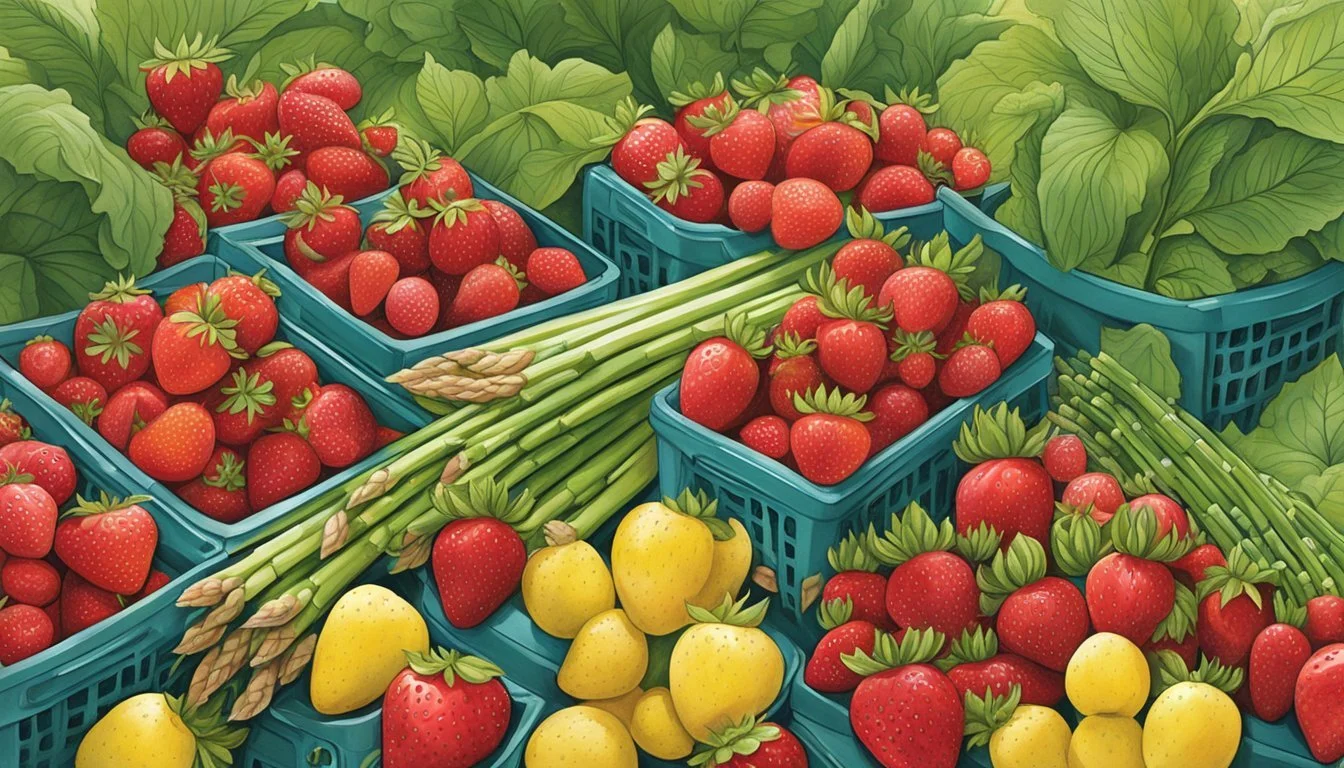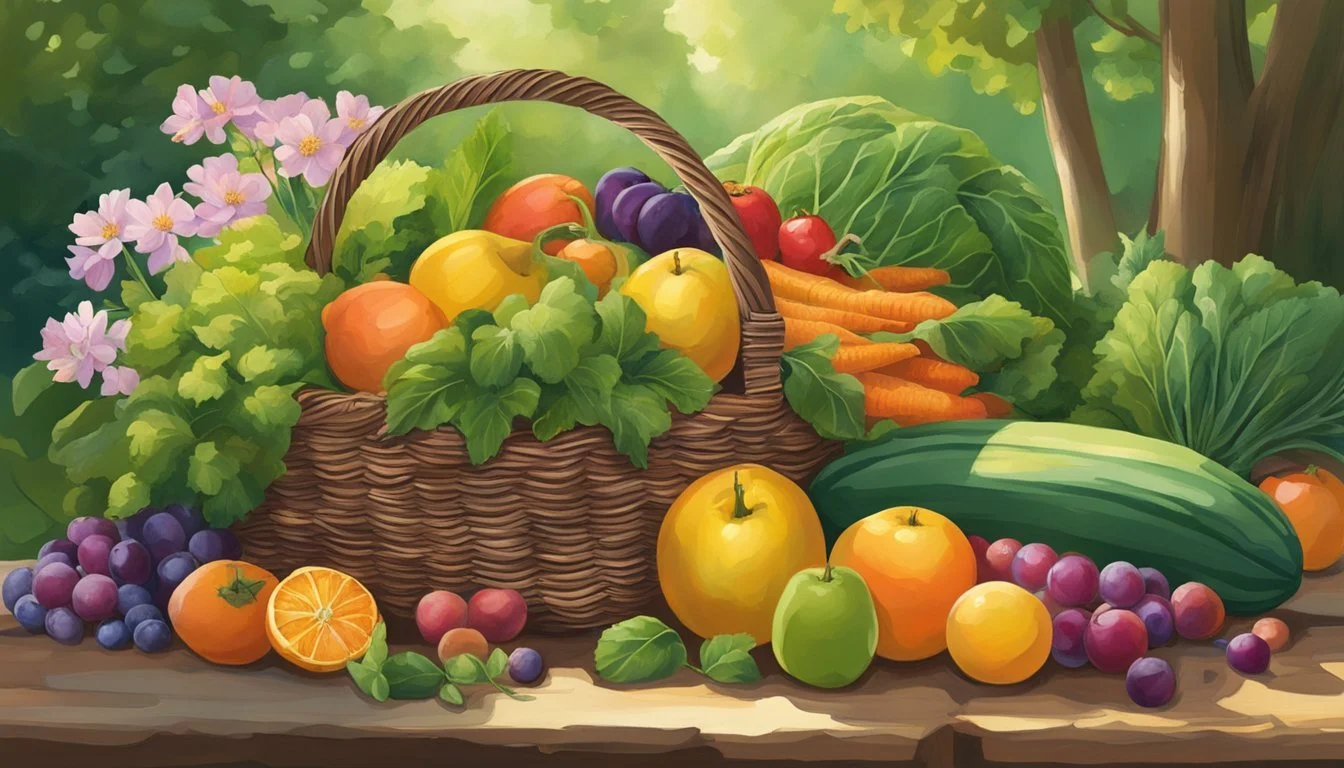Maryland Seasonal Fruit & Vegetables in April
Your Guide to Local Produce
This Article is Part of our Maryland Seasonal Fruit & Veg Calendar
As spring sets in, Maryland offers a diverse variety of fruits (What wine goes well with fruit?) and vegetables that not only promise freshness but also support local farms and sustainable agriculture. April is a transitional month where the last frost gives way to warmer days, allowing for an array of produce to start hitting the farm stands. Maryland's unique climate and rich soil contribute to the growth of several seasonal crops during this time, ensuring that consumers have access to nutrient-rich and flavorful produce.
During April, Maryland's fields and orchards begin to yield fresh produce, marking the start of a fruitful season. The state's agricultural prowess becomes evident as local markets start to showcase an assortment of fruits and vegetables. Leafy greens like spinach and lettuce thrive in the cool, early spring weather, while root vegetables such as radishes start to make their appearance. As gardeners and farmers plant new crops, the anticipation of summer's bounty begins to build.
Understanding Seasonal Eating in Maryland
In Maryland, seasonal eating is influenced by the state's diverse climate, which defines what and when fruits and vegetables are at their peak. A shift towards eating with the seasons offers benefits both nutritionally and environmentally.
Benefits of Seasonal Eating
Eating seasonally means consuming fruits and vegetables around the time they are harvested. Benefits of this practice include:
Enhanced Flavor: Produce that hasn't traveled long distances is fresher and often tastes better.
Higher Nutrient Content: Seasonal produce can be richer in nutrients because it is sold closer to its harvest time.
Support for Local Economy: Buying seasonal items supports Maryland's farmers and the local economy.
Environmental Sustainability: Seasonal eating can reduce the carbon footprint associated with long-distance transport of out-of-season produce.
The Role of Climate in Produce Seasonality
Maryland's climate plays a crucial role in determining the seasonality of produce. Here are specific ways how climate interacts with produce availability:
Temperature and Rainfall: The state's varying temperatures and precipitation levels throughout the year affect the growth cycles of fruits and vegetables.
Frost Dates: Maryland's frost dates influence when planting and harvesting occur, thereby defining the seasons for certain crops.
Seasonal Produce in April:
Fruit: While April is not a peak season for fruit in Maryland, there may be some lingering storage apples and the start of greenhouse-grown strawberries.
Vegetables: Cool-season vegetables thrive in April. Look for leafy greens like spinach and lettuce, root vegetables like radishes and turnips, and the beginning of asparagus (What wine goes well with asparagus?) season.
Embracing Maryland's seasonal produce can lead to enjoying fresher, tastier, and more nutritious foods while supporting the state's farmers and reducing environmental impact.
April's Seasonal Vegetables
In April, Maryland’s vegetable selection begins to welcome the spring with a range of leafy greens, hearty root vegetables, and nutritious cruciferous options. Shoppers and gardeners can enjoy the first flush of fresh produce that the season brings.
Leafy Greens Varieties
Spinach, kale, and lettuce are prime choices for leafy greens in April. They provide a versatility for salads, sautees, and smoothies that health-conscious consumers relish.
Spinach: A nutrient-dense green, high in iron and vitamins, it's often used for salads and cooking.
Kale: This robust green offers a slightly peppery taste and is packed with fiber.
Lettuce: There's an array of lettuce types with crisp or tender textures perfect for refreshing spring salads.
Root Vegetables in Season
Hearty root vegetables like radishes and turnips find their way into Maryland's April markets. They offer a peppery or sweet note to dishes and can be consumed raw or cooked.
Radishes: Offer a crunchy texture and a spicy kick, ideal for salads or as a garnish.
Turnips: These can be mashed, roasted, or added to stews for an earthy flavor.
Cruciferous Vegetables Options
April in Maryland is not complete without broccoli and cabbage, which belong to the cruciferous family renowned for their health benefits.
Broccoli: This versatile vegetable can be steamed, roasted, or enjoyed raw; it's rich in vitamins C and K.
Cabbage: It can be served in slaw, soups, or fermented to create sauerkraut (how long does sauerkraut last?), offering both flavor and nutrients.
These vegetables serve as harbingers of spring, signaling a shift to lighter and more vibrant cooking styles appropriate for the season.
April's Seasonal Fruits and Berries
In April, Maryland delights in the blossoming of spring with a modest yet promising selection of fruits and berries that begin to make their seasonal appearance.
Early Season Berries and Fruits
Strawberries: One of the first beloved signs of spring, strawberries start to emerge in April, offering their sweet and tangy flavors.
Rhubarb: While technically a vegetable, rhubarb is often used as a fruit in culinary practices. It's tartness is ideal for pies and jams and starts to become available this month.
Maryland's cool spring climate is conducive to the gradual ripening of these fruits and berries, ensuring they develop a rich, full flavor. As the month progresses, availability can vary, with local markets and farms beginning to offer these early seasonal delights.
Herbs and Other Produce
In Maryland, April ushers in a plethora of fresh herbs (how long do fresh herbs last?) and assorted produce that are both flavorful and nutritious. Gardeners and farmers diligently tend to their crops, ensuring a bountiful harvest.
Seasonal Herbs
April is the prime time for a variety of herbs in Maryland. The mild temperatures and increased daylight encourage the growth of aromatic herbs that are perfect for culinary use or decorative purposes. Among the most commonly cultivated herbs during this month are:
Parsley: This versatile herb thrives in the cool, spring weather and is used widely for its fresh, clean taste in dishes.
Chives: (how long do chives last?) Known for their mild onion flavor, chives are an excellent addition to salads, soups, and potato dishes.
Mint: With its refreshing taste, mint is particularly popular in drinks, desserts, and as a garnish.
Unique Produce Varieties
Beyond herbs, April in Maryland is marked by the arrival of distinctive greens and other unique produce varieties which include:
Leeks: These provide a subtle, sweet onion flavor and are ideal for enhancing the taste of soups and stews.
Greens: A variety of leafy greens come into season, among them are tender spinach and robust kale, full of vitamins and minerals.
The inclusion of these fresh herbs and produce can elevate the simplest of meals into something special. Maryland's April harvest allows for a seamless incorporation of freshness and flavor into local cuisine.
Preparation and Preservation Tips
When preserving Maryland's seasonal produce in April, it is essential to prioritize proper cleaning, storage methods, and preservation techniques. This ensures maximum flavor retention and longevity of fruits and vegetables.
Cleaning and Storage
Before storing, all produce should be washed under cold running water to remove any dirt or bacteria. Leafy greens may require a gentle soak, while more resilient vegetables like carrots can be scrubbed. Once clean, proper storage is key:
Leafy greens: Wrap in a paper towel and store in the crisper drawer of the refrigerator.
Root vegetables: Keep in a cool, dark place or refrigerate to prolong freshness.
Fruits like strawberries: Store in a breathable container in the fridge to avoid excess moisture which leads to mold.
Canning and Freezing Techniques
To preserve the peak flavor and nutritional value, one can turn to canning or freezing:
Canning: Suitable for making fruit jams or pickles. All jars and lids should be sterilized, and the canning process followed accurately to ensure safety.
Jam: Follow specific fruit to sugar ratios for best set and flavor.
Pickles: Use a vinegar solution for canning to create a brine that preserves crunch and taste.
Freezing: Best for items like berries and sliced vegetables. Blanch vegetables before freezing to preserve color and texture.
Freeze fruits and vegetables in single layers on trays before transferring to airtight containers to prevent clumping.
Preparing Fresh Herbs
Fresh herbs add a burst of flavor to any dish. To ensure longevity and ease of use:
Wash and thoroughly dry herbs. Excess moisture can cause decay.
Store wrapped in a damp paper towel inside a container in the refrigerator for short-term use.
For longer preservation, chop herbs and freeze in an ice cube tray with water or olive oil, creating convenient flavor cubes for cooking.
Maryland's Produce Calendar
Maryland's climate and soil yield a diverse array of fruits and vegetables. The state's produce calendar highlights what's in season each month, allowing consumers to plan for the freshest picks.
Month-by-Month Guide
April in Maryland signals the arrival of spring's early bounty. Specifically, it brings:
Fruits: Strawberries begin to make an appearance, signaling the start of berry season.
Vegetables: Asparagus, lettuce, and spinach are typically ready for harvest.
This table gives a snapshot of what to expect in April:
Fruits Vegetables Strawberries Asparagus Lettuce Spinach Spring Onions
One must carefully track the local harvest calendars for the most accurate information, as harvesting times may vary due to weather conditions.
Planning for Seasonal Variations
Farmers and consumers alike should be prepared for variations that can affect the availability and quality of produce. Unexpected cold snaps or unseasonably warm weather can accelerate or delay growth cycles. Rainfall levels also impact how juicy or sweet fruits can be, and drought conditions can lead to smaller yields. Monitoring local weather patterns and staying in touch with local farmers can provide insight into these seasonal dynamics.
Local Food Movements and Events
Maryland's strong commitment to local food movements is evident in its community-supported agricultural practices and events. These events not only foster a connection between consumers and local producers but also celebrate the state's rich agricultural heritage.
Farmers Markets
Throughout Maryland, farmers markets take on a pivotal role during April. They provide consumers with fresh, locally-sourced fruits and vegetables, and other artisanal products.
Baltimore: The Baltimore Farmers' Market & Bazaar, held on Sundays beneath the Jones Falls Expressway, is one of the largest in the state.
Annapolis: The Annapolis Freshfarm Market offers a broad range of seasonal produce from local farmers.
Festivals and Agricultural Events
The state often hosts festivals and events that highlight local produce, even in the early spring. While April's offerings are more limited, these gatherings preview the abundance of upcoming months.
Maryland's Ice Cream Trail: Beginning in spring, this trail is a beloved agritourism venture that leads participants to dairies and creameries across the state.
Earth Day Events: Many communities hold events in April that include a focus on sustainable farming and local food production.
Agritourism Opportunities
Agritourism in Maryland is an immersive way for visitors to experience agricultural life first-hand.
Farm Visits: Farms may offer tours to showcase how local foods are grown and to educate visitors on sustainable agriculture.
Christmas Tree Farms: Although not in season, some farms are open year-round, offering planning insights for the end-of-year festivities.
Note: While many seasonal fruits and vegetables are not yet available, these movements and events continue to keep the spirit of local and sustainable consumption alive for the community.
Recipes and Cooking Inspiration
With April's arrival in Maryland, the focus on utilizing seasonal produce is both a culinary delight and a sustainable choice. The recipes provided here are designed to showcase the fresh flavors of local fruits and vegetables in full bloom this season.
Seasonal Recipes
Spring Vegetable Lasagna: Featuring freshly harvested asparagus and young carrots, this dish layers vibrant vegetables with creamy cheese and pasta, embodying the essence of spring in each bite.
Strawberry Cobbler: As strawberry season peaks, this dessert combines ripe, juicy strawberries with a golden-brown crust, perfect for a sweet and fruity end to any meal.
One can capture the fresh essence of Maryland's spring produce through these enticing recipes, which are both nourishing and flavorful.
Cooking with Local Ingredients
Cooking with local ingredients not only supports Maryland's agricultural community but also ensures the highest level of freshness and flavor. Here are some tips for cooking with April's seasonal produce:
Asparagus: Known for its tender texture and grassy notes, asparagus can be roasted, grilled, or steamed to complement any main course.
Radishes: With their crisp bite and peppery flavor, radishes make a refreshing addition to salads or can even be pickled for an extra zing.
Using these local ingredients, one can craft dishes that are true to Maryland's seasonal palette.
Supporting Maryland Agriculture
Supporting the agricultural efforts in Maryland not only sustains the local economy, but it also ensures consumers receive fresh produce. Maryland's Agriculture is rich and diverse, with April bringing a range of seasonal fruits and vegetables to local markets.
Community-Supported Agriculture (CSA)
Community-Supported Agriculture (CSA) is a model where consumers buy shares of a farm's harvest in advance. In Maryland, CSA members receive regular deliveries or pickups of fresh, locally-grown produce, forming a direct link between the farmers and the community. This system provides farmers with a much-needed income boost at the start of the growing season.
Benefits of Buying Local
Purchasing local produce has multiple benefits:
Freshness: Locally grown fruits and vegetables are often harvested within 24 hours of being sold, ensuring peak freshness and flavor.
Nutrition: Fresh produce loses nutritional value over time; local produce is typically more nutritious due to shorter transit times.
Economy: Buying local keeps money within Maryland's community, supporting family farms and preserving agricultural land.
Environment: Reduced transportation distances mean less fuel consumption and lower greenhouse gas emissions.








